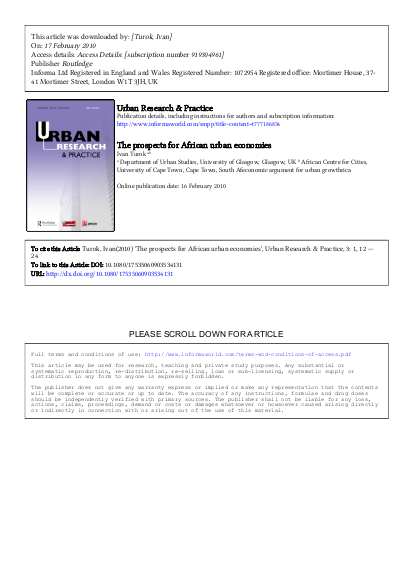
Throughout the world, economic growth and rising living standards have tended to go hand in hand with urbanization. Cities have been both sources of wealth creation and sites of power for the expropriation and accumulation of wealth. Dense concentrations of population and trade have spurred human progress through creative problem-solving, entrepreneurial discovery and improvements in the division of labour – finding new ways of doing things and new things to do. The transition from agriculture to manufacturing industry has involved the biggest transformation of the economic and human geography of nations. China is the latest example of a country where large-scale rural–urban migration is fuelling industrialization and economic development.
One of the puzzles about Africa’s rapid urbanization is that this has not been accompanied by greater economic dynamism. No less than 43% of its urban population lives below the poverty line (UN-Habitat 2008). Has Africa urbanized prematurely, perhaps in response to environmental disasters and ethnic conflicts in rural areas? What has stalled the economic forces normally associated with urban density that should have created more jobs and higher incomes? And how do Africa’s highly populated cities manage to sustain themselves and avoid social disorder and collapse without a stronger economic base? More importantly, what can be done to overcome the economic weaknesses of African cities and to stimulate faster growth and development?
This paper considers some of the distinctive features of African urban economies, including their structure and development. It begins by considering the applicability to the African context of the general argument that cities are drivers of economic progress. Subsequent sections test the relevance of the idea that cities develop more complex, higher value functions over time. The penultimate section examines the recent revival of African economies, at least until the global downturn, and the conclusion asks whether the fashionable idea of enhanced international integration through cross-border collaboration might facilitate greater urban prosperity.
Resource collections
- UN Habitat - Urban Response Collection
- Urban Response - Urban Crisis Preparedness and Risk Reduction
- Urban Response Collection - Community Engagement and Social Cohesion
- Urban Response Collection - Economic Recovery
- Urban Response Collection - Environment and Climate Change
- Urban Response Collection - Housing, Land and Property
- Urban Response Collection - Urban Crisis Response, Recovery and Reconstruction
- Urban Response Collection - Urban Resilience